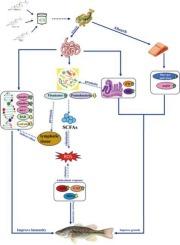A new insight on the application of phytosterols in the aquatic feed: Improve the growth and intestinal health of largemouth bass (Micropterus salmoides) fed the high starch diet
IF 2.2
2区 生物学
Q4 BIOCHEMISTRY & MOLECULAR BIOLOGY
Comparative Biochemistry and Physiology D-Genomics & Proteomics
Pub Date : 2025-08-25
DOI:10.1016/j.cbd.2025.101617
引用次数: 0
Abstract
This study investigated the effects of phytosterols (PS) supplementation in high-starch diets on growth, antioxidant capacity, muscle/intestinal morphology, and gut microbiota in largemouth bass (Micropterus salmoides). A total of 960 fish (11.14 ± 0.48 g) were divided into six groups (Control, 8 % starch; HC, 13 % starch; HCP1-HCP4: HC + 0.025 %/0.05 %/0.075 %/0.1 % PS) for an 8-week feeding trial. Compared to the HC diet, dietary supplementation of 0.05 % PS significantly enhanced the growth and anti-oxidative ability of largemouth bass, as well as reduced MDA concentration and suppressed digestive enzyme activities. PS supplementation improved intestinal health by increasing muscle fiber density and intestinal fold width, also up-regulated the expression of bcl-2, claudin-1, claudin-4, and mef2d while downregulated the expression of murf1, atrogin1, and mstn (P < 0.05). PS modulated apoptosis by elevated BAD protein fluorescence intensity while reduced BCL-2 and CASPASE-3 protein fluorescence intensity (P < 0.05). Additionally, compared to HC diet, dietary supplementation of 0.05 % PS increased Firmicutes abundance and decreased Proteobacteria abundance. These findings demonstrated that 0.05 % PS supplementation in HC diets improved growth performance, muscle quality, antioxidant capacity, intestinal integrity, and beneficial microbiota composition of largemouth bass.

植物甾醇在水产饲料中应用的新认识:促进高淀粉饲料喂养的大口黑鲈生长和肠道健康
本试验研究了高淀粉饲料中添加植物甾醇(PS)对大口黑鲈生长、抗氧化能力、肌肉/肠道形态和肠道微生物群的影响。将960尾鱼(11.14±0.48 g)分为6组(对照组,淀粉含量为8%;HC,淀粉含量为13%;HCP1-HCP4: HC + 0.025% / 0.05% / 0.075% / 0.1% PS),进行为期8周的饲养试验。与HC饲粮相比,饲粮中添加0.05% PS显著提高了大口黑鲈的生长和抗氧化能力,降低了MDA浓度,抑制了消化酶活性。添加PS可通过增加肌纤维密度和肠折叠宽度改善肠道健康,上调bcl-2、claudin-1、claudin-4和mef2d的表达,下调murf1、atrogin1和mstn的表达(P < 0.05)。PS通过提高BAD蛋白荧光强度,降低BCL-2和CASPASE-3蛋白荧光强度调节细胞凋亡(P < 0.05)。此外,与HC相比,饲粮中添加0.05%的PS提高了厚壁菌门的丰度,降低了变形菌门的丰度。综上所述,HC饲料中添加0.05% PS可改善大口黑鲈的生长性能、肌肉品质、抗氧化能力、肠道完整性和有益菌群组成。
本文章由计算机程序翻译,如有差异,请以英文原文为准。
求助全文
约1分钟内获得全文
求助全文
来源期刊
CiteScore
5.10
自引率
3.30%
发文量
69
审稿时长
33 days
期刊介绍:
Comparative Biochemistry & Physiology (CBP) publishes papers in comparative, environmental and evolutionary physiology.
Part D: Genomics and Proteomics (CBPD), focuses on “omics” approaches to physiology, including comparative and functional genomics, metagenomics, transcriptomics, proteomics, metabolomics, and lipidomics. Most studies employ “omics” and/or system biology to test specific hypotheses about molecular and biochemical mechanisms underlying physiological responses to the environment. We encourage papers that address fundamental questions in comparative physiology and biochemistry rather than studies with a focus that is purely technical, methodological or descriptive in nature.

 求助内容:
求助内容: 应助结果提醒方式:
应助结果提醒方式:


